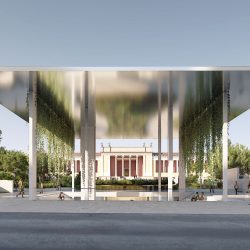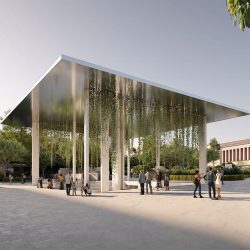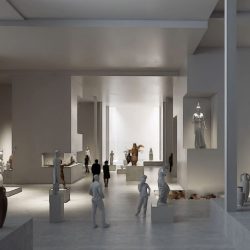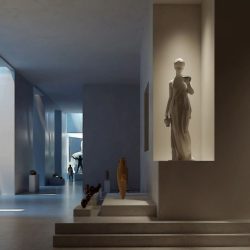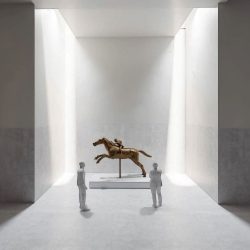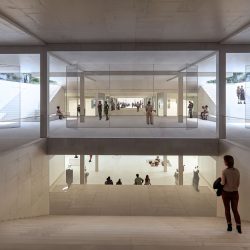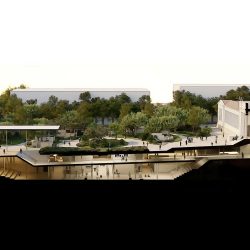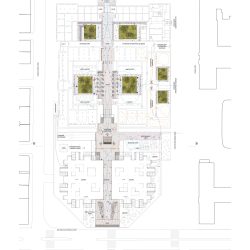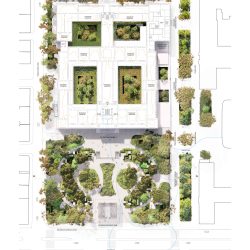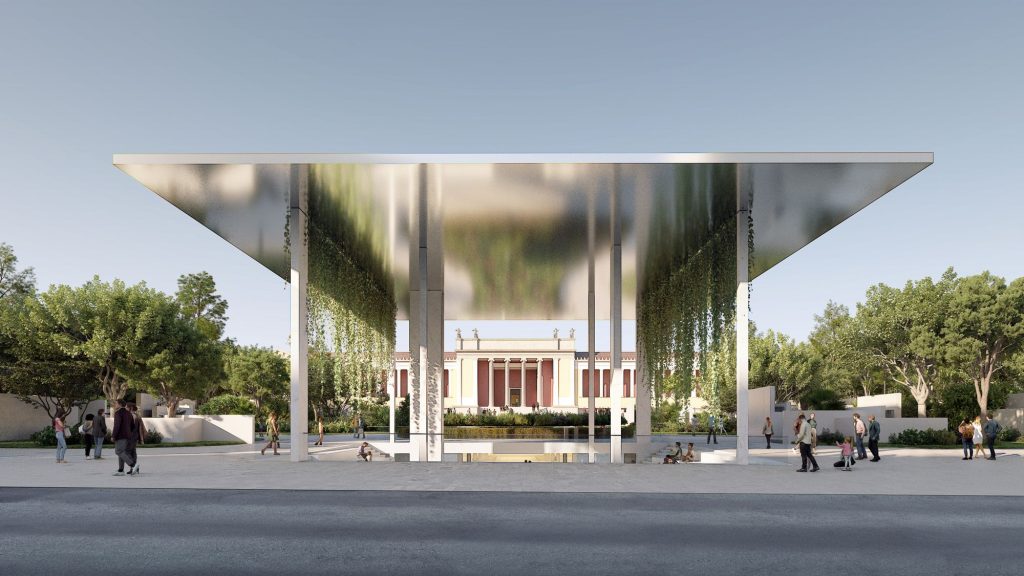
WHAT
We open up the Museum, integrate it with the park and connect it to the surrounding neighborhood. Like urban acupuncture we improve the circulation in and around the Museum by creating new access points, opening arteries, animating many types of experiences and enhancing the ongoing regeneration of the Exarchia neighborhood. The Museum and the City become one. The extended and revitalized National Archaeological Museum will become an urban magnet and a place for ALL – museum visitors, tourists, scholars and the citizens of Athens at large.
HOW
We introduce the STOA as a new axis through the garden and the existing building where visitors and passers-by can wander without a ticket, experiencing the GARDEN, historic courtyards and the exhibition spaces with glances down into the AGORA. The Exarchia neighborhood, a developing part of Athens, will be connected to Patission Street, the city’s main cultural axis and a significant ceremonial route of the Capital. The AGORA is an extension of the exhibition spaces that will offer a wide range of new curatorial opportunities. This large new hall has an architectural narrative analogous to spaces of archaeology, geology and nature. With a quarrylike appearance, the AGORA will be a contemporary, radical contrast to the existing building which will be cleaned, restored and reinvigorated in its neoclassical beauty. We enhance the GARDEN. Certain walls of the AGORA protrude upwards,
forming skylights, walls and benches. Together with a lush new landscape, the representational neoclassical park will be transformed into a usable and livable garden for ALL. The GARDEN demonstrates how museums conceived at
first as closed treasure chests can become animated social places of exchange and leisure. The STOA, AGORA, GARDEN and the carefully renovated existing building combine to form a new whole, where the historical informs the new and vice versa.
GARDEN
The physiognomy of the historic GARDEN is maintained by keeping the largest existing trees at the site perimeter while inverting the proportion of soft and hard landscapes. Vegetation is maximized and planting is extended throughout the entire complex, including the historic courtyards. The Entrance Pavilion on Patission Street is the most prominent new exterior architectural feature. It is a large, light roof that marks renewal and welcome, as well as a respectful gesture that allows for an open view from Patission Street to the existing Museum. Combined with a wall of falling water and the lush greenery of the GARDEN, the new pavilion is a pleasant place of encounter for the senses and invites visitors to discover the Museum below.
AGORA
The AGORA encompasses three types of architectural elements. Horizontal podiums, platforms and floor recesses are counterbalanced by two types of vertical structures: peripheral niches with skylights as well as a series of semi- permanent anchor rooms in the center, called “monoliths”. These specifically developed curatorial vessels can be arranged in many different ways, allowing for various exhibition formats and diverse perceptions of the artifacts. The architectural elements of the AGORA, the niches, platforms and anchor rooms, can be complemented by projections or AR that recreate the found habitats of the archaeological pieces with contemporary approaches. The atmosphere of the historical galleries on the upper levels, with their decor and finish recalling the original setting of the artifacts, is punctually reflected in the new extension below. When the Museum was first built, natural daylight was the only means of illumination. In the new underground extension, daylight accents and establishes a relation with the outside world through the skylights above the niches, sunken courtyards and a large window at the Entrance Pavilion.
Precisely controlled artificial light responds to contemporary exhibition requirements, highlighting the works on display and providing the best conditions for the maintenance and the visitor experience.
STOA
The STOA is the project’s main urban intervention. Beginning at the Entrance Pavilion, its first stretch hovers above the AGORA, then delves under the existing building. The STOA offers a trajectory through history and archaeology and creates a strong connection between Patission Street and Exarchia. The STOA is not a new invention in name nor in function – this passage through the city is a common urban typology in Athens and already exists in the genes of the existing Museum. The STOA connects all existing and new activities in the Museum like a vibrant street: the Entrance Pavilion, the AGORA, the library and the restaurant, the auditorium and the amphitheater, the historical main entrance and galleries, the existing courtyards, the Epigraphic Museum, the new entrance to Kountouriotou Street and the new entrance to Tositsa Street, serving important urban functions by- establishing a direct connection with the National Technical University of Athens and the Acropole Across.
Herzog & de Meuron, December 2022
_
Project Official Name National Archaeological Museum of
Greece
Location Athens, Greece
Project Phases Competition Jun 2022 – Dec 2022
Milestones stage 1 Jun 2022 – Oct 2022
stage 2 Nov 2022 – Dec 2022
Client Hellenic Ministry of Culture and
Sports, Athens, Greece
Client Representative Hill International (Hellas), S.A., GR,
Athens, Greece
PROJECT TEAM
Herzog & de Meuron
Project Team
Partners: Jacques Herzog, Pierre de Meuron, Stefan Marbach
(Coupling Partner) Andreas Fries (Partner in Charge)
Project Team: Tomislav Dushanov (Project Director), Elena Klinnert
(Project Manager), Konstantinos Katsas (Project Manager)
Oscar Amicabile, Evgenia Angelaki, Massimo Corradi, Tomislav
Dushanov, Elliott Friedman, Rafael Gonçalves, Vasileios Kalisperakis,
Konstantinos Katsas, Woohee Kim, Elena Klinnert, Roberto Monticelli,
Niklas Nalbach, Felipe Pecegueiro Curado, Martin Schulte, Jacob
Steinberg, Victoria Svendsen, Marina Tsintzeli
PLANNING
Design Consultant
Herzog & de Meuron Global Ltd. Basel, Switzerland
Local Architect
Aeter Architects, Athens, Greece
Landscape Architect
H. Pangalou & Associates Landscape Architects, Athens, Greece
Museographer
Studio Adrien Gardère, Paris, France
Structural Consultant and Sustainability
Arup International Projects Limited, London, UK
Consultant on integration of the new NAM in to the social, cultural and urban context in Athens
and Greece
Tense Architecture Network, Athens, Greece
BUILDING DATA
Site Area 313’444 sqft 29’120 m
Gross floor area (GFA) 398’264 sqft 37’000 m
Outside Facilities 184’493 sqft 17’140 m
Number of levels 4


